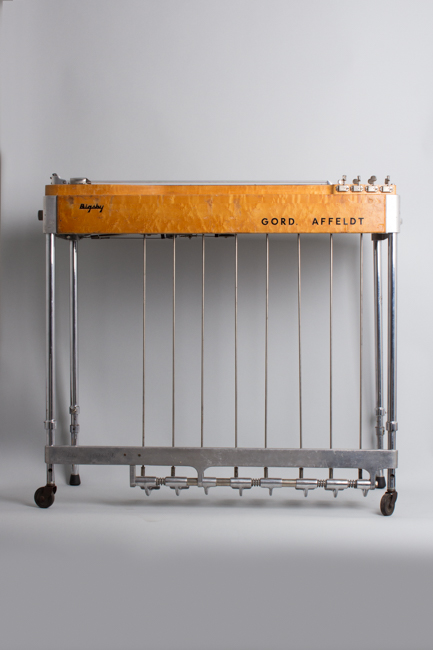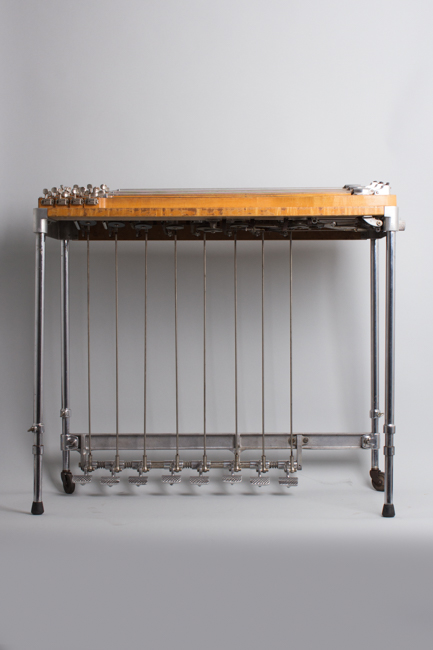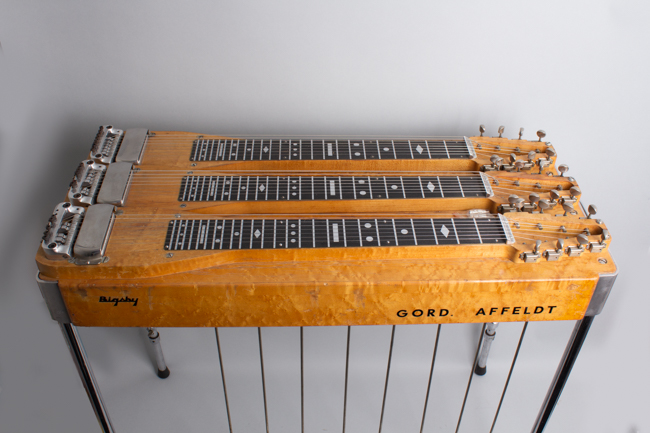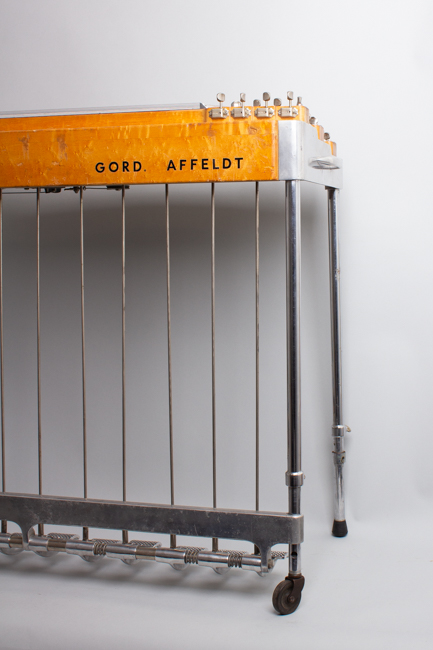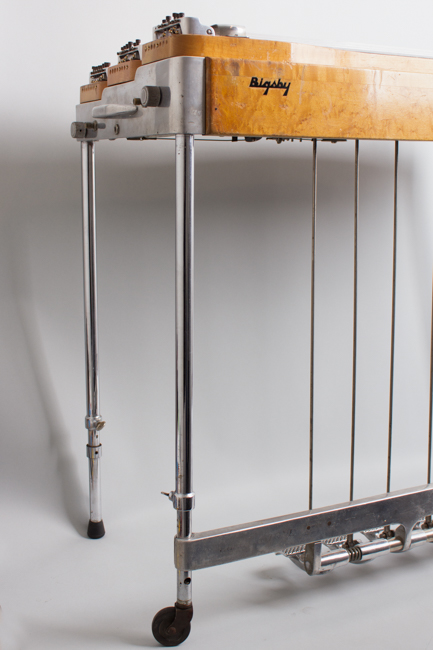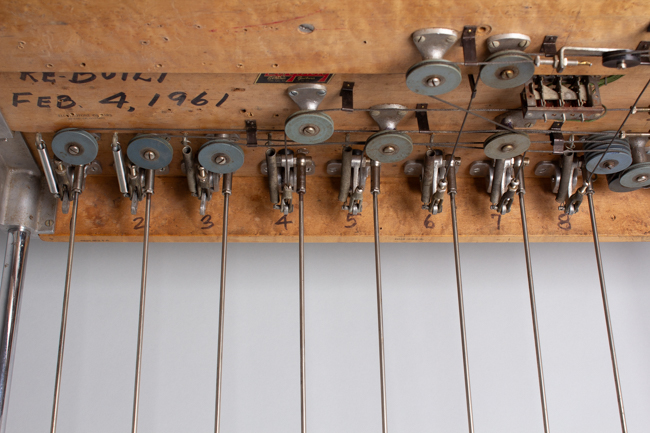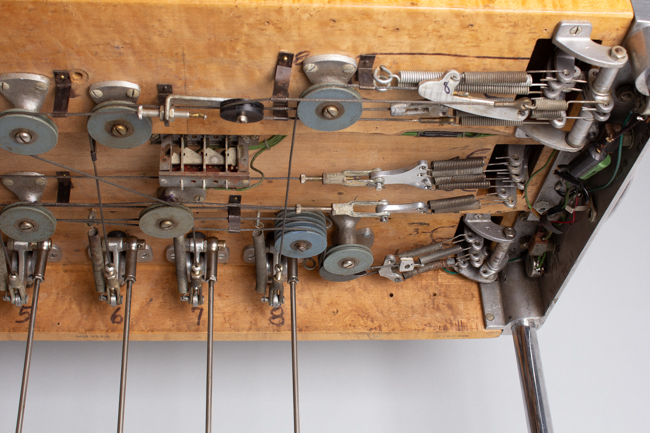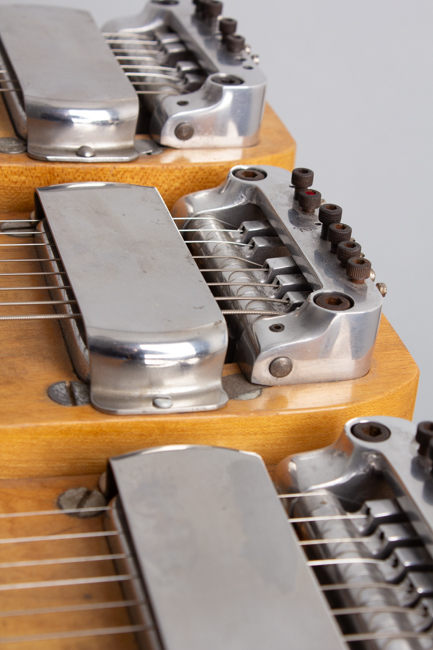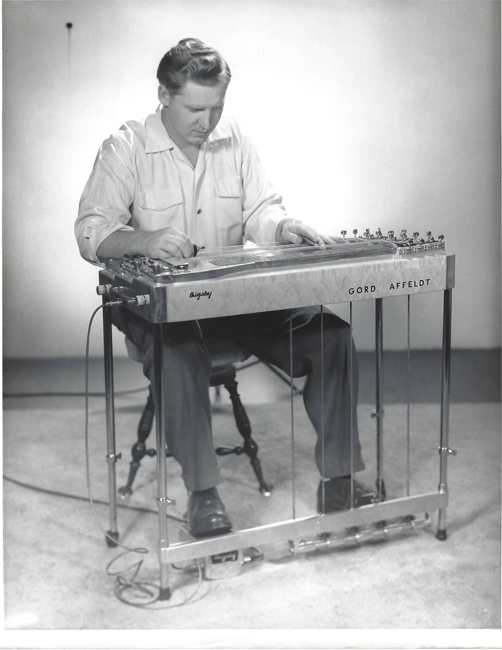Bigsby T-8 Pedal Steel Electric Guitar (1958)
This item has been sold.
Item # 12103
Prices subject to change without notice.
Bigsby T-8 Model Pedal Steel Electric Guitar (1958), made in Downey, CA, serial # 61558, natural lacquer finish, maple body and necks, black hard shell case.
This is one of the most elaborate and coolest original Bigsby instruments we have seen, a triple-eight pedal steel from the late 1950s with a total of eight pedals. It was originally shipped in June 1958 to a customer in Canada who must have proved one of Bigsby's most picky clients, as he returned the instrument not once but twice for extensive revisions! That player was Gord Affeldt of Waterloo, Ontario, who had a local career as a pedal steel artist, appearing with Johnny Siska and the Silver Bar Ranch on CKCO TV in the 1950s as well as a show called the Sunset Riders. In the early 1960s Affeldt was one of the few proficient pedal steelers in the Ontario region and frequently appeared with both Canadian and touring acts from the US. He retired the instrument in the 1970s and it has sat unused "under the bed" for many decades now, recently receiving a tune-up from Bigsby maven Todd Clinesmith.
This instrument comes with VERY extensive documentation of a somewhat complex history. As originally built is had three aluminum necks and five pedals; the first receipt dated 6-6-58 signed by Paul A. Bigsby includes the note "with foot pedals as specified". The cost was $925, but this was just the beginning. Less than a year later the steel was returned to Bigsby for an upgrade, resulting in another receipt for $194 worth of work dated 6-15-59. In early 1961 the instrument received an even more extensive rebuilding by Bigsby, who billed another $484.34 for the work. In a very detailed note P.A. enumerated the parts and labor required, noting (possibly with some annoyance) "It would have been $625 had I charged regular price"! After that Affeldt seemed satisfied and ordered only parts and strings, a final receipt dated to November 1965, not long before Paul Bigsby retired and sold the company. Not only are these original receipts included (written in ink in Bigsby's own hand) but the extensive import-export paperwork survives as well, fully documenting Affeldt's very expensive search for the perfect steel. By the end the customs valuation was $1574.00, making this one of the priciest guitars in the world!
The instrument that emerged from this process was the epitome of Bigsby's art and Gord Affeldt's ambitions. It has eight pedals, three for each side neck and two for the center. The cabling underneath is incredibly elaborate, and appears to have been completely redone in 1961 as numerous older screw holes dot the underside. "REBUILT FEB 4, 1961" is written in LARGE letters on the underside, as if Bigsby wanted to make sure this was not forgotten. The maple necks were also new, replacing aluminum ones originally installed. This rectified a complaint of Affeldt's that in cold Canadian winters the guitar would go out of tune when brought inside from the car. He even mentioned leaving it under dashboard so the running engine would keep it warm!
Apart from all this the guitar has standard Bigsby features, with GORD. AFFELDT and the Bigsby logo on the front panel of the maple body. The three blade pickups are covered by handrests, and there are handles on each aluminum endpiece. The tuners are single-line Kluson Deluxe, and the volume and tone controls have milled aluminum knobs. Everything works as intended and this is a fantastic sounding historical instrument, about as original as they come with as perfect original documentation as we have ever seen.
Overall length is 33 in. (83.8 cm.), 15 1/2 in. (39.4 cm.) across at the widest point, and 3 3/4 in. (9.5 cm.) in depth, measured at side of rim.
This 65 year old steel shows signs of professional use but has been well maintained, and the only work ever done was by P.A. Bigsby himself except for the recent once-over by Todd Clinesmith. "I made a new case for it, set it up, cleaned it up and repaired one of the platforms" is his description of the work performed. The finish shows wear on the top of the decks with some checking and minor flaking and chipping, with heavier wear to the back edge of the body. There are some deeper dings over the Bigsby logo as well.
There is some light corrosion and scuffing to some of the metalwork, but for the age and amount of use this instrument has seen it is very well preserved. The tunings the instrument was set up for appear to be C6 with 1st string to G on the inside neck, Bud Isaacs' E9 on the middle and the outside neck has 3 pedals for an E9 variation. The instrument is fully playable and has a sound for the ages. As noted the original case is apparently lost, but the new custom Clinesmith reproduction does the job well. This is a truly historic piece and an amazing part of the Bigsby legacy, even though it probably caused P.A. himself some headaches when it was new! Excellent - Condition.
This is one of the most elaborate and coolest original Bigsby instruments we have seen, a triple-eight pedal steel from the late 1950s with a total of eight pedals. It was originally shipped in June 1958 to a customer in Canada who must have proved one of Bigsby's most picky clients, as he returned the instrument not once but twice for extensive revisions! That player was Gord Affeldt of Waterloo, Ontario, who had a local career as a pedal steel artist, appearing with Johnny Siska and the Silver Bar Ranch on CKCO TV in the 1950s as well as a show called the Sunset Riders. In the early 1960s Affeldt was one of the few proficient pedal steelers in the Ontario region and frequently appeared with both Canadian and touring acts from the US. He retired the instrument in the 1970s and it has sat unused "under the bed" for many decades now, recently receiving a tune-up from Bigsby maven Todd Clinesmith.
This instrument comes with VERY extensive documentation of a somewhat complex history. As originally built is had three aluminum necks and five pedals; the first receipt dated 6-6-58 signed by Paul A. Bigsby includes the note "with foot pedals as specified". The cost was $925, but this was just the beginning. Less than a year later the steel was returned to Bigsby for an upgrade, resulting in another receipt for $194 worth of work dated 6-15-59. In early 1961 the instrument received an even more extensive rebuilding by Bigsby, who billed another $484.34 for the work. In a very detailed note P.A. enumerated the parts and labor required, noting (possibly with some annoyance) "It would have been $625 had I charged regular price"! After that Affeldt seemed satisfied and ordered only parts and strings, a final receipt dated to November 1965, not long before Paul Bigsby retired and sold the company. Not only are these original receipts included (written in ink in Bigsby's own hand) but the extensive import-export paperwork survives as well, fully documenting Affeldt's very expensive search for the perfect steel. By the end the customs valuation was $1574.00, making this one of the priciest guitars in the world!
The instrument that emerged from this process was the epitome of Bigsby's art and Gord Affeldt's ambitions. It has eight pedals, three for each side neck and two for the center. The cabling underneath is incredibly elaborate, and appears to have been completely redone in 1961 as numerous older screw holes dot the underside. "REBUILT FEB 4, 1961" is written in LARGE letters on the underside, as if Bigsby wanted to make sure this was not forgotten. The maple necks were also new, replacing aluminum ones originally installed. This rectified a complaint of Affeldt's that in cold Canadian winters the guitar would go out of tune when brought inside from the car. He even mentioned leaving it under dashboard so the running engine would keep it warm!
Apart from all this the guitar has standard Bigsby features, with GORD. AFFELDT and the Bigsby logo on the front panel of the maple body. The three blade pickups are covered by handrests, and there are handles on each aluminum endpiece. The tuners are single-line Kluson Deluxe, and the volume and tone controls have milled aluminum knobs. Everything works as intended and this is a fantastic sounding historical instrument, about as original as they come with as perfect original documentation as we have ever seen.
Overall length is 33 in. (83.8 cm.), 15 1/2 in. (39.4 cm.) across at the widest point, and 3 3/4 in. (9.5 cm.) in depth, measured at side of rim.
This 65 year old steel shows signs of professional use but has been well maintained, and the only work ever done was by P.A. Bigsby himself except for the recent once-over by Todd Clinesmith. "I made a new case for it, set it up, cleaned it up and repaired one of the platforms" is his description of the work performed. The finish shows wear on the top of the decks with some checking and minor flaking and chipping, with heavier wear to the back edge of the body. There are some deeper dings over the Bigsby logo as well.
There is some light corrosion and scuffing to some of the metalwork, but for the age and amount of use this instrument has seen it is very well preserved. The tunings the instrument was set up for appear to be C6 with 1st string to G on the inside neck, Bud Isaacs' E9 on the middle and the outside neck has 3 pedals for an E9 variation. The instrument is fully playable and has a sound for the ages. As noted the original case is apparently lost, but the new custom Clinesmith reproduction does the job well. This is a truly historic piece and an amazing part of the Bigsby legacy, even though it probably caused P.A. himself some headaches when it was new! Excellent - Condition.
